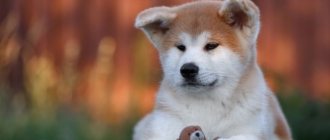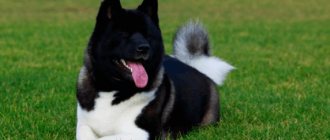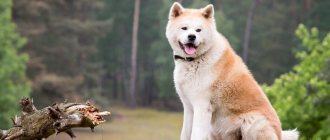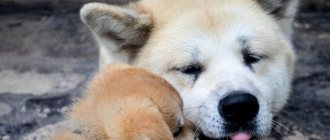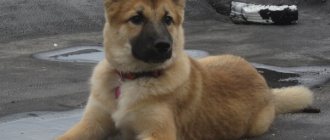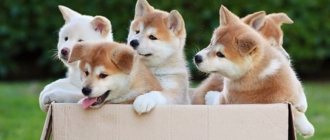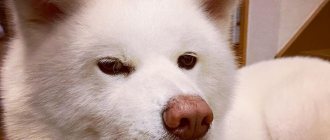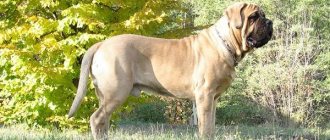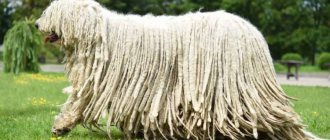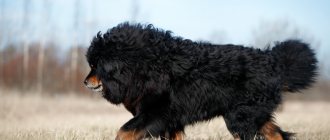Akita Inu can be described in one succinct word - “dignity”. The birthplace of the breed is Japan, so it is not surprising that they represent a national symbol and are considered a real “treasure of Japan.”
Dogs of this breed are very popular not only because of their unique appearance, but also because these animals have a very balanced character, while these pets are quite devoted to their owner, as well as members of the entire family. The story of the dog Hachiko, a member of the Akita Inu breed, is proof of his special devotion to humans.
History of the breed
Akita Inu is a breed that originated in Japan, on the island of Honshu. In her homeland she became a real legend and is known to every local resident. Some people mistakenly believe that the Japanese Akita and the American Akita are the same breed of dog, but this is not the case. Akita Inu, or the Japanese Akita dog, appeared in the north of the country. This happened in the province of Akita, which is why the breed got its name. Historians cannot say with certainty exactly when these animals appeared. But everything suggests that the breed was formed by the 17th century, as evidenced by various records and drawings. In those days, dogs were used as bodyguards for the emperor and his family.
Akita Inu photo
They took Akita Inu with them on hunting trips. The dogs coped with this task perfectly, bringing both small and large game. There is information that they could even cope with a bear. This quite accurately characterizes the character of the Akita Inu. On the one hand, these are kind and cheerful dogs, and on the other hand, they are distinguished by their fearless disposition and strength. Good nature runs in the blood of this breed. At the London Zoo, one of the dogs even became a “nanny” for a baby tiger, which delighted the entire staff.
The Akita Inu came to the USA with a famous woman at that time - writer Hellen Keller. She was blind and deaf. The woman learned the story of a dog named Hachiko, visited his monument and decided to take one of the representatives of this breed with her to her homeland. They named the dog Kamikaze-go.
After the war, many servicemen began to bring these wonderful dogs with them to America. Thanks to this, a separate breed of dog appeared - the American Akita. Disputes about the difference between these dogs and Akita Inu continue among breeders to this day. In Japan, the Kennel Association does not recognize the American Akita as a separate breed.
Features of the American Akita
The American branch of this breed appeared precisely after World War II, when US military personnel began to export puppies to their homeland. It is interesting that they were mainly interested in large mestizos, somewhat similar to bears, and not purebred dogs. This played into the hands of Japanese dog breeders, who did not want to share the laboriously recreated breed.
Selection experiments continued in the USA, where they managed to obtain more massive dogs with a menacing appearance - which is why we now have two varieties of the breed with significant differences. The Americans managed to gain recognition from the AKC (American Kennel Club, an organization that registers purebred dogs and new breeds) only after refusing to import new dogs from Japan. This led to a severe limitation of the gene pool, and therefore the development of the breed as such. The Japanese continued to work on colors, since they had a large variability of genes at their disposal. Today, the Akita Inu is considered a good companion, a devoted protector of the owner and his property.
Description of the Akita Inu breed
Akita Inu is a large Spitz-like dog. An adult female of this breed can weigh from 32 to 45 kilograms, and a male - from 40 to 45. The height at the withers for females is from 58 to 64 centimeters, for males - from 64 to 70. The dogs' muscles are quite developed, the animal requires constant exercise and training .
Head
Head. The forehead is wide and powerful. The cheeks are wide and flat. Insufficiently wide cheeks indicate a poorly developed neck. There are faint grooves running along them. The stop line is curved and clearly visible. A convex forehead with deep wrinkles is considered a defect.
Muzzle. Regular shape, without skin folds. Wide and elongated, gradually tapering towards the nose.
Ears. Small in size, triangular in shape. They have a forward tilt. They stand tensely. Ears that are too large, as well as the presence of folds, roundings, and bends on them, are considered a defect. The base is wide, placed on the skull at an average distance from each other.
Nose. The lobe is quite large and black. Males that are white or light in color are allowed a pink or brown nose.
Mouth. It has a specific structure, due to which it seems that the dog is constantly smiling.
Teeth. Snow-white and strong. The bite has a scissor-shaped bite.
Lips. The lips fit well to the teeth and have dark pigmentation.
Eyes. They have a triangular shape. The outer corner is slightly raised. The color of the iris is brown, with a reddish tint.
Neck. Powerful and wide, quite massive. She is built strongly and has well-developed muscles. It should not be too elongated with skin dangling on it.
Frame
Frame. The back is straight, the thighs are well muscled. A raised or concave back is a defect. The hips run in a straight line towards the tail.
Breast. Deep, wide and developed. The depth should not be less than half the height of the dog at the withers. The ribs are strong. The chest in the section should have an ovoid shape. Barrel chest is considered a fault.
Tail. Strong and thick, curled and covered with dense hair. Can be twisted both to the right and to the left. There is a “tambourine” curl, when the tail is curled several times, this is considered undesirable. A hanging tail is grounds for disqualification.
Limbs
Front. The bones of the shoulder blades are inclined and well developed. The tilt angle is from 110 to 120 degrees. Shoulders and elbows fit tightly to the chest. When looking at the dog from the front, the line of the forearm should be straight. The paw print should be round with a convex shape. Gaps between fingers are not allowed.
Rear. Powerful, with strong hocks set at an angle of 150 to 155 degrees. Stand straight hip-width apart when looking at the dog from behind.
Wool
The Akita Inu has coarse and straight guard hairs and a thick and densely packed undercoat. On the shoulder blades and in the “pants” area of dogs, the hair is slightly longer, and the longest is on the tail.
According to the breed standard, the coat must consist of three layers. Long guard hairs make up the top layer. Then comes the same hard one, but less short. The third layer is a weightless and soft undercoat. Wool is very important for this breed, as it greatly affects the appearance of the animal. There are dogs with short or longer hair. Both of these options are acceptable and do not constitute a deviation from the standard.
The Longhaired Akita Inu is a dog that differs from other representatives of this breed in having longer hair. This feature is clearly visible and expressed on the ears, tail, and back of the paws. There are fringes on the body.
It is noteworthy that the gene for long hair is recessive. A puppy with this type of hair may appear if both or one of the parents is a carrier. Other characteristics of long-haired Akita Inu are no different from their short-haired “brothers”. But some breeders claim that long-haired dogs have larger and more massive bones. It is believed that the Akita Inu inherited the gene for long hair from a breed called Karafuto-Ken or Sakhalin Husky.
Colors
The canine community cannot come to a consensus on the acceptable colors of Akita Inu. But the World Canine Organization accepted only four:
- White color. In the Russian Federation, such dogs are still rare. They are very popular in Japan. The white color is considered the “youngest”, because it was bred only at the beginning of the twentieth century. No stains are allowed on the dog's body, oh. But a “mantle” of a blue or silver hue, on the contrary, is highly valued. It is incorrect to consider white Akita Inus to be albinos. Their eyes and nose are black, as are their lips. Dogs of this color are prone to allergies; they require special nutrition so that yellowish spots do not appear on the ears and face.
- Black color. Meeting a pure black Akita Inu is very difficult. Upon closer inspection, it turns out that the dog has barely noticeable stripes of a lighter shade. Black color is not acceptable by all standards.
- Tiger color. Such wool is also a curiosity in Russia. Color can be blue, white, black, red. The stripes are located throughout the body, except for the head. The brindle color is so unique that there are no two identical dogs in the world with this coat.
- Red color. It is also called red. The most common and familiar. Shades from yellow to rich red are allowed. The dog must have white markings on the cheeks, chest, belly and inside of the limbs. A darker color on the face is unacceptable and is considered a defect. The exception is the American Akita. Red puppies are born gray or black, with a permanent coat color appearing after the first molt. The famous dog Hachiko was precisely red in color.
Varieties
Due to certain circumstances, many new types of Akita Inu have appeared.
| Name | History of the origin of the variety | Peculiarities |
| American Akita Inu | During World War II, dogs of this breed were actively exterminated, as warm clothing for soldiers was made from the animal’s wool. Only German Shepherds were preserved that were capable of serving well in the war. To save their pets, the owners came up with the idea of crossing Akitas with German shepherds so that the puppies would look like Germans and not be touched. This is how the American Akita Inu turned out. | The Japanese dog is much smaller than its American counterpart, which is noticeably larger. There are differences in color and character between the two varieties. |
| Akita Inu mini | Dwarf variant | A small breed, adult individuals are almost 2 times smaller than a normal representative. The dog's appearance is no different. |
| Tiger Akita Inu | This breed is a cross between an Akita Inu and a German Shepherd. | A distinctive feature is the unusual brindle color, which consists of black, white and red stripes. |
| Longhaired Akita Inu | This variety is not a special type of breed. | This variety is distinguished from ordinary Akita Inu only by its long hair. Puppies are born this way only if both parents have the gene for long hair. |
Akita Inu and Shiba Inu have minor differences. Both breeds are distinguished by boundless devotion and incredible oriental temperament.
Akita Inu character
Akita Inu are ideal candidates for the role of a companion, and they are suitable not only for families with children, but also for single people. However, representatives of the breed are very active, and this may disappoint people who dream of a calm pet.
Akita Inu is one of the most ancient breeds in the world. It is believed that these dogs are the embodiment of the spirit of Japan. According to some sources, the first mention of animals similar to Akita dates back to the second millennium BC.
Dogs of this breed are smart, curious and very stubborn. They need training and constant contact with humans, starting from childhood. However, the Akita Inu is difficult to train and is not a dog that will immediately fetch a ball and run after toys for the owner's pleasure. It is for this reason that experts do not recommend starting an Akita for novice dog breeders.
Representatives of the Japanese breed are independent and willful, they have leadership qualities and demand respect for themselves. Persistence, respect and perseverance are the main components of success in raising an Akita.
In relationships with people, the Akita Inu is a full-fledged member of the family who loves children and happily supports their games. However, these dogs do not always have good relationships with animals - they need early socialization.
Features of character and behavior
The Japanese would not be able to appreciate this dog if it did not suit them in character and behavior. Akita, like a real samurai, has a reserved character, behaves with dignity, is reasonable and intelligent. But behind the calm restraint hides kindness, sincere joy and a hot temperament. Akita Inu is a worthy example of canine devotion and fidelity. You need to love a dog and then it will reciprocate.
Advantages
The advantages of the Akita include its devotion, restraint, intelligence, and curiosity. Akita is capable of selflessly standing up for its owner and coming to the aid of its relatives, despite the degree of danger, sometimes risking its life.
Flaws
The breed's minor disadvantages include the dog's rather late maturation, which requires more careful and lengthy training. Teenage curiosity and childish fun can sometimes be excessive. Impatient or rude owners may experience the dog's pride and insubordination, as the dog does not like strong pressure and tends to dominate.
Training and education of the breed
Most dog trainers agree that the Akita Inu is not an easy dog to train. Therefore, inexperienced owners may have problems in this field.
This is due to the special character that has been ingrained in the breed for centuries. These dogs are stubborn, independent, willful, proud and want to be leaders. Such qualities do not have the best effect on the educational process. But, besides this, these dogs are distinguished by high intelligence. This means that with the right approach, you can achieve tremendous results in training. But you need to remember that a dog with high intelligence will not only quickly remember commands, but will also not repeat them without any apparent reason. Therefore, you must find an “approach” to your pet and establish a trusting relationship with him so that he listens to you in any situation.
If you adopt a puppy, spend the first few days getting to know him better. You will immediately see the distinctive character traits of your pet. This will help you choose the right approach to the animal and simplify training in the future. Then the dog needs to be socialized. And the sooner you do this, the better. If you have children in your family, then explain to them the rules of behavior with animals. Akita Inu is great with kids and can become their friend or nanny.
Then start introducing the puppy to the outdoors. Start with short walks close to home. At the same time, the dog gets used to the leash. A dog must learn from an early age to communicate with other animals, since a poorly socialized dog will certainly show aggression towards them. This is especially true for males.
Toilet training can be done while the puppy is still too small. If you live in a private house or are ready to leave your apartment with your dog five to ten times a day at first, then you can immediately try toilet training on the street. Do not scold the little puppy if he “didn’t have time” and made a puddle on the floor. This is a lot of stress for the dog. Over time, the dog will get used to walking twice a day and these puddles will become a thing of the past.
Photos of Akita Inu training
Since the Akita Inu is highly intelligent, there is no point in putting off training the dog. As soon as the puppy appears on your territory, he will try to become a leader and “leader”. It is important not to miss this moment, since it will be extremely difficult to correct such a situation later. Raise your baby from the first days, and you can start training as early as three months.
If we compare Akita with other dog breeds, such as Labrador or Shepherd, the first one requires much more attention, perseverance and time in training. Be patient, the stubborn Akita will test your nerves regularly. The training method should be based solely on affection and praise. You should not yell at your dog; this can provoke aggression, cowardice or complete disobedience in the future. Hitting a dog is strictly prohibited, as is applying any other corporal punishment to it. A proud Akita Inu will never forget or forgive you for treating her like this.
To encourage the training process, you can use your four-legged friend's favorite treats. This will not only reinforce the command, but will also encourage the pet to perform it again.
At a “young” age, when you have not yet started serious training, you can teach your dog the following basic skills:
- relieve yourself on a diaper;
- do not bite, even during play;
- walk with a collar and leash;
- do not ask for food at the table and do not pick it up from the floor;
- do not jump on you or others;
- stop barking on demand;
- come when called by the owner.
When the dog reaches four months of age, you can begin teaching him basic commands. Start with simple “Sit!”, “Give me your paw!”, “Voice!”, “You can’t!”, “Come to me!” When the Akita Inu masters them, you can teach your pet more complex commands, as well as tricks.
If you feel that you cannot cope with training, then the best option would be professional help from a dog handler. With this breed of dog, it wouldn’t hurt to take a general training course, where a specialist will point out your pet’s “problem” areas.
Key points in training
You should start training your dog from a very early age. Having acquired a puppy, you need to not only accustom him to street walks, but also teach him the rules of behavior in the family, show him his place in the “master-dog” hierarchy.
Read about how to properly train a dog in the article: “Training a puppy: effective methods from dog handlers, learning commands at home.”
Genetically, the Akita has decent behavior with people and relatives, but it is necessary to push the puppy to the right actions. Otherwise, the puppy will grow into a self-sufficient dog that wants to dominate the pack family. A special feature of Akitas growing up is their long childhood. Only after 2 years does the Akita become an adult dog, childishness disappears, and behavior and body are finally formed.
Responsible and experienced owners usually raise and train the puppy themselves. But inexperienced dog breeders can contact kennel clubs and enroll in OKD courses, where a professional canine instructor works with dogs in groups or individually. With an experienced eye, he will identify problems in the dog’s behavior and help the owner find ways to eliminate them.
The key to successful training is tact and patience, affection and consistency.
Under no circumstances should physical violence be used against an Akita; training should be based only on encouragement and positive emotions.
Maintenance and care
The Akita Inu has a fairly thick coat and dense undercoat, which is why the dog needs to be brushed weekly using special brushes. During the molting period, this must be done every day.
A thick undercoat can cause a lot of trouble for those who were not prepared for such an active dog shedding. Even constant brushing does not always save you from hair that will settle everywhere. If you want to speed up the process of “shedding the undercoat,” you can contact a groomer. In salons there is such a procedure as express shedding. It is absolutely safe. The dog will simply be “helped” to shed faster on a professional level, and your apartment or house will remain clean.
Representatives of this breed are rarely bathed - no more than 3 times a year, and always use special products for dogs.
It is often impossible to wash Akita Inu, as their natural protective lubricant is washed off from the coat. But you can wash your dog by wiping his face with a damp cloth several times a week so that he looks clean and tidy. The ears are wiped with a cotton swab dipped in a special lotion. Nails should be trimmed at least once every two months. Teeth also need care. Plaque is removed from them using a special brush and paste, which can be purchased at a veterinary clinic or pet store.
The dog must be accustomed to all these procedures from puppyhood. Otherwise, you will face problems in the future. This breed has a rather powerful build, so you are unlikely to be able to forcibly hold it for hygiene procedures.
Hurry up, choose a box and find out what gift awaits you
Discount on pet insurance
Promo code copied to clipboard
Akita Inu is an excellent city dweller who adapts to an apartment without any problems. At the same time, representatives of the breed feel great outside the city if the owners live in a private house. But we must understand that Akita Inu cannot live on a leash, separately from a person; its place is in the house.
The diet of representatives of this breed should consist of high-quality food that contains a large amount of nutrients and nutrients, since the Akita is a fairly large and energetic dog. In addition, she needs daily activity. At a minimum, the owner needs to walk the pet two to three times a day for an hour.
Different areas of use
Companion
This dog breed is suitable for both large families and single people. In the whole world it is difficult to find a better companion for a person than the Akita . She respects her master, but does not serve him. In order to find a common language with such a dog, you need to choose a partner communication style.
Hunting with Matagi Ken
Matagi Ken or American Akita is a type of breed that takes part in hunting bears and other large animals. They can intelligently assess the enemy and calculate their strength. They are ready to completely devote themselves to what interests them, very passionately.
The preparation of hunting Akitas is no different from the preparation of huskies, and takes place in two stages: baiting and grooming. Education begins at an early age.
Fighting dog
Fortunately, in the modern world they are not used as fighting dogs. In 1603, when dog fighting took place, Akitas began crossing with mastiffs and other large dog breeds. The size of the dog increased, but the original measurements and Spitz-like appearance were lost. And only in 1908, after the ban on dog fighting, breeders and breeders began to restore the purebred of the breed.
Security
Today, dogs of this breed are often used as house guards. Akitas themselves are very reserved and silent . But in case of danger, he will always come to the rescue and give his voice. The Japanese have this belief: when an Akita barks, it means you need to worry. He treats strangers without aggression, but with great caution and distrust.
What and how to feed?
The best choice for Akita Inu is high quality commercial food. Manufacturers add all the vitamins, minerals, micro- and macroelements necessary for dogs. Therefore, by buying food from a trusted manufacturer, you don’t have to spend money on additional additives for your pet.
But every owner must remember that selecting food can take a lot of time. You may be lucky and your first attempt will be successful right away. But it may also happen that the food will need to be changed more than once. It all depends on the individual characteristics of the dog, its reaction to the composition, as well as taste preferences. In addition, Akita Inu is one of those dogs that can “turn up their nose” at the contents of a plate if they don’t like it. You must understand exactly when a dog is just being capricious, and when it has health problems.
To choose the right food, follow these tips:
- Do not purchase economy class food. Most likely, such a gourmet as an Akita Inu will simply refuse them. Super premium food is suitable for Akita.
- Choose a diet that does not contain soy protein. Excessive consumption leads to deterioration in the health and appearance of dogs of Asian breeds.
- Avoid feeds that contain grains such as corn and wheat. They do not have the best effect on the functioning of the Akita Inu’s gastrointestinal tract. The granules should contain lean meat, fish, and rice.
- Pay attention to the balance of the BJU. Manufacturers indicate it on the package. This is very important, especially for puppies. Kids, for example, need to receive at least 25% protein from their entire daily diet, and the fat level should be below 18%.
- Give preference to specialized lines of food for Akita Inu, abandoning universal options. Nutrition should be appropriate for the age and health of the dog.
- If necessary, consult your veterinarian. He will help you choose food.
It is better for pregnant and lactating bitches to choose a higher calorie diet, additionally enriched with vitamins and calcium.
Hachiko's story. Fiction or truth
The whole world learned about who Hachiko was thanks to cinema. People cried when watching films about a faithful dog. Two of them were filmed. In 1987, the Japanese film The Story of Hachiko was released. In 2000, the Americans filmed a remake of it, “Hachiko: The Most Faithful Friend.” The role of the professor in it was played by Richard Gere. It was the second option that most Russians looked at. People were not only touched by the tragic fate of the Akita Inu, they wanted to know the true story of the legendary dog. In the American version, events developed in the USA. The story actually took place in Japan in Akita Prefecture.
The real Hachiko was born on November 10, 1923. He was the eighth dog in the life of the Japanese scientist Hidesaburo Ueno. That's why he named his pet Hachiko. Translated from Japanese as “eighth”. There is another meaning for this word - “devotion”. Some experts argue that the nickname given to an animal affects its fate. Not everyone agrees with this statement. However, the fate of Hachiko is a clear confirmation of this.
The dog has grown up. Every morning he accompanied his master to Shibuya Station, from where he left for work in Tokyo. Hidesaburo Ueno taught at the capital's university. The dog was returning home. By three o'clock in the afternoon I returned to the station again. I met the professor.
On May 21, 1925, the irreparable happened. At work, during a lecture, the professor had a stroke. Those around him were unable to provide him with the necessary help. Ueno died.
At that time, Hachiko was one and a half years old. That day, as usual, he arrived at the station at three o'clock in the afternoon. I waited until evening. To no avail.
The next day, at three o'clock in the afternoon, the dog again came to meet the train. History repeated itself day after day. Hachiko did not lose hope. He hoped that his loving owner would return one day. The dog spent the night on the porch of the owner's house. Relatives and friends tried to take the dog home. The dog didn't want this. At the first opportunity, I ran away from them and returned to the station. Local merchants and railroad workers fed him out of pity. So seven years passed.
One of the professor's students wrote an article about an old and faithful Akita Inu, who has been waiting for many years for the return of his deceased owner, and published it in a major Tokyo newspaper. The story shocked Japan.
People flocked to Shibuya Station, where the events unfolded. They came only to see the devoted dog with their own eyes. Some dreamed of taking Hachiko with them. However, they failed to do this. The dog did not pay attention to them, did not make contact, did not accept the affection of strangers, and continued to live according to his own schedule.
The loyalty and devotion that the dog kept towards the deceased person aroused respect and admiration. People decided to erect a monument to the legendary Akito Inu. The opening ceremony took place on April 21, 1934. At that time, Hachiko was still alive. According to eyewitnesses, the dog himself was present at the event and indifferently contemplated what was happening.
In 1935, Hachiko died. It happened on the street adjacent to the station. As an autopsy later showed, the cause of death was heart disease, which had begun to progress to cancer. By that time, the dog had already become a four-legged hero throughout the country. National mourning was declared over his death.
Some of the remains of the faithful dog are buried in Tokyo's Aoyama Cemetery, the other is stuffed in the capital's Science Museum.
During the Second World War, the monument to the faithful Akita Inu was dismantled for military purposes. The country needed metal. After the war, in August 1948, it was restored at the request of the people.
Flowers are brought to the statue of the legendary dog, located on the pedestal. Lovers make dates near her. Tourists take pictures. For the Japanese, the Akito Inu Hachiko remains a symbol of fidelity and love.
In 2015, a second monument to the legendary dog was opened at the University of Tokyo. Its official name is “Statue of Hachiko and Dr. Hidesaburo Ueno.” However, residents of the capital call it differently - reunion.
The sculptor captured the moment Hachiko met her owner. Hachiko dreamed about this event for nine long years. I didn’t wait in my lifetime. People have united a faithful dog and its owner in bronze.
Akita Inu Health and Diseases
The Akita Inu breed can “boast” of quite good health, which nature itself has awarded the dogs. But they also have diseases to which dogs are more susceptible than others. These include:
- hip dysplasia;
- allergies;
- gastrointestinal diseases, including gastric volvulus;
- eye diseases;
- problems with the thyroid gland.
The owner must remember that the Akita Inu, like other dog breeds, needs timely vaccination. Vaccinations will protect your pet from many deadly diseases. The puppy receives the first vaccine against distemper and enteritis at four weeks. A month later, revaccination is carried out and a vaccine against hepatitis and leptospirosis is added. At twelve weeks the dog is vaccinated against rabies. Then vaccinations need to be repeated once a year.
During the warm season, the dog is treated for fleas and ticks every month. Once a quarter they give tablets against parasites to prevent their occurrence.
Health
Akita Inu are healthy dogs. Common problems include:
- Hip dysplasia.
- Gastric volvulus.
- Eye diseases: progressive retinal atrophy, entropion, cataracts, glaucoma.
Preventative measures to protect your Akita Inu puppy
- To keep your Akita Inu puppy completely safe, you first need to minimize his contact with unfamiliar dogs, especially stray dogs. Therefore, you should not let your dog off the leash, as in this case it will become impossible to control its behavior and communication with other dogs. Since a dog can easily become infected with distemper from simply touching the nose of a sick animal. This disease can be transmitted to a dog through sniffing. Your dog can become infected with trichophytosis from contact with the lichen-affected fur of a sick dog. Naturally, it is impossible to completely exclude a dog’s communication with other dogs, since it must be socialized. Therefore, try to find friends with dog lovers who look after their animals. By adhering to this rule, you can eliminate the risk of pathogen transmission by 80%.
- You should walk your dog in places where there are no landfills. Since garbage very often attracts rodents, which in turn are very often carriers of various infections. Gray rats are especially dangerous because they carry such a serious disease as leptospirosis.
- You should not allow your dog to sniff other people's feces, as they are a source of worms.
- Monitor your Akita Inu's health. Pay attention to even the most minor changes in his behavior. For example, your dog may appear lethargic, lose his appetite, or have a dry nose. Or you may notice that the dog begins to shed, and this has nothing to do with seasonal shedding. If hair loss becomes excessive, this is the first symptom indicating health problems in your pet. And only you can help him. Therefore, it is important to take the dog to the veterinary clinic in time, where the disease can be overcome for sure. In no case should you ignore the symptoms, since advanced infections are much more difficult to treat, and sometimes even impossible. If you start treating your dog, the disease can lead to his death or he will develop serious complications that will affect his hearing, vision, limbs and much more.
Photos of adult Akita Inu dogs
Interesting Facts
In its homeland, the Akita is a cult dog. She is considered an excellent companion, protector of the home, and a symbol of good health. There is a tradition, when a child is born in a family, to give the parents a figurine of an Akita. Such a gift symbolizes the wish of happiness, health and longevity. A person receives the same souvenir if he is very sick. Friends and relatives express their support for him in this way and wish him a speedy recovery.
The Japanese Akita is one of the world's most popular dog breeds used as companions. She competes with Labradors for the title of “best companion.” In the USA, these balanced, friendly dogs are specially trained and used in medical centers for the rehabilitation of people who have suffered serious illnesses or are struggling with serious illnesses. Akitas provide convalescents with emotional support in the fight against the disease. They are used for the same purpose in nursing homes.
If you look at an Akita Inu, the dog may appear to be smiling. The point is the special structure of the jaws.
On the Akita's paws, the toes are pressed tightly together. It's like they grow together. Due to this, it seems that they are connected by membranes. The special structure of the paw allows the dog to correctly distribute its weight so that it can easily move through the snow. For the same reason, Japanese dogs feel great in water - they swim well.
In 1977, the Akita Inu Museum was established in Odate, Japan. The exhibits presented there tell the history of the breed. The office of the Society for the Protection and Preservation of Akita Inu is located in the same city. This organization annually holds breed championships and selects the best representatives.
In 2012, Akita Prefecture Governor Norihisa Satake presented an Akita Inu puppy to Russian President Vladimir Putin. The gift was presented as a token of gratitude for Russian assistance in eliminating the consequences of the 2011 earthquake. The puppy was given the name Yume. Translated from Japanese into Russian as “dream”.
Who is this breed suitable for?
As soon as a film about the legendary dog Hachiko, who was of the Akita Inu breed, appeared on the screens, the popularity of these dogs increased sharply. But not everything that people saw on the screen turned out to be reality. Few people were ready for the “live” Akita and its character traits.
Akita Inu will not “look into your mouth” and catch the owner’s mood. Rather, this dog will prefer that you consider its feelings and desires. This independent breed is definitely not suitable for a novice owner. Training her, although interesting, is quite difficult.
If you have a soft character and you cannot refuse a dog, then it will get the better of you and will be the main one in the family. This breed is very easy to spoil. As a result, you will end up with an uncontrollable animal that will not be to blame for this at all.
Unfortunately, many owners who did not realize that they would face such difficulties in raising them abandon their dogs. Therefore, there are more and more purebred and expensive dogs in shelters, to which the owners have not found an approach.
Long walks and exercise are important for Akita Inu. Therefore, the breed is not suitable for those who cannot devote time to this. The dog feels good in the apartment. But you will have to walk with her for at least several hours a day. Otherwise, excess energy will be splashed out on your furniture, shoes and other personal items. A big plus for keeping an Akita Inu in an apartment is that the animal does not bark without a reason. In general, this breed prefers a wide variety of sounds to barking, including grunting.
Akita Inu does not get along well with other dogs unless they were raised with her. Dogs of this breed will also be partial to small animals and cats. But they always find a common language with children. Therefore, the Akita Inu is suitable for a family with children. Provided that one of the parents will be involved in her upbringing.
Attitude towards children and pets
They will be tolerant of children and pets if they have lived with them since childhood.
Dogs have a good memory, which is why they can remember the slightest insult from a child . This fact should not be ignored. A hidden grudge can backfire. If you get along with the dog, he will play for hours with the child and is patient. Bitches are more suitable for a family.
Aggressive towards other dogs . Akita Inu always tries to dominate dogs, which causes fights. If you have pets, conflicts may arise.
Famous owners
The most famous Akita Inu dog is a dog named Hachiko. It belonged to Japanese professor Eisaburo Ueno. Every day the dog accompanied his owner to the station, and then met him when he returned from work. But, unfortunately, the professor became ill during the lecture and died suddenly. Hachiko did not wait for his master that day.
But that didn't stop the dog. Every day at the same time he came to the station, hoping to meet his master. This lasted 11 years, until Hachiko's death. Many people learned about the unusual dog, they wrote a book about him, made a film, and even erected a monument to the animal as a symbol of true loyalty and devotion.
Many domestic and foreign stars have dogs of this beautiful breed living at home. For example, Natalia Ionova (singer Glukoza) has a dog named Muftik.
Prices
The price of an Akita Inu depends on the status of the animal: show, breed or pet class.
- Show class are dogs that have clearly expressed breed characteristics. In Moscow they cost from 65 thousand to 100 thousand rubles.
- If you buy second hand, puppies without a pedigree cost from 3,000 to 6,000 rubles. If you have a veterinary passport and card - from 4,000 to 8,000 rubles.
- If the dog does not have a pedigree or it belongs to the pet class, you will pay up to 35 thousand rubles for it in Moscow, and in the regions you can count on the cost being 20-40% lower.
- Puppies with a pedigree cost from fifty thousand to 70 thousand rubles.
Many people practice booking Akita puppies in nurseries, both Russian and foreign, including Japanese. It costs about 80,000 rubles. In Japan, prices range from 2500 to 3000 euros.
Tips for choosing a puppy
To purchase a purebred Akita Inu puppy, it is better to go to a club or professional breeders. When choosing a baby, pay attention to the fact that it comes from a small litter. Be sure to check out the dog's pedigree. Find out what awards the puppy's parents received. It would not be the best option if they are closely related. Then the puppy may develop many genetic diseases.
Pay attention to whether the puppy eats well. He should be playful, curious and active. The dog should not be afraid of a hand extended to it. It’s good when a dog comes up with interest and sniffs you.
Mating
Despite the fact that the final maturation of Akitas occurs only at two years, females can be bred from 12-15 months, and males from 10-12 months (depending on the degree of readiness of a particular dog).
- Estrus occurs twice a year, usually lasts about 18-25 days , it is best to mate a bitch on 10-14 days from its onset.
- Before the planned mating, the bitch must be shown to a veterinarian to exclude problematic situations during pregnancy. If at the time of the planned pregnancy the vaccination schedule requires vaccination, then they need to be spaced out in time. One month before pregnancy and during it, vaccinations should not be given.
- Recently, vaccines have been released that are labeled “Safe for Pregnant Dogs,” but this should be discussed with your doctor. You also need to clarify the availability of vaccinations and the health status of the male dog.
- You can only breed bitches that are ready for mating (swollen loop, light discharge, indifference when meeting male dogs). If estrus has begun, and the dog does not show interest in the opposite sex and does not “twist” its tail to the side when stroking the croup, then it is better to postpone the “wedding” until next time.
- The first mating of a pair is successful if one of the dogs has experience of this kind, that is, a young male should be mated for the first time with an experienced female , and it is advisable to pair a young bitch with an experienced male. Two inexperienced dogs during a “wedding” may become confused, experience stress, and this will not end well.
- It is recommended to arrange the mating in the dog's territory, but the bitch must be familiar with the surroundings. That is, before an important meeting, it is advisable to bring the dog into the house and introduce it to the “groom” and his owner. Mating is carried out in two stages, on day 1 - the main mating, on the next day - control mating.
The cost of breeding is usually equal to the cost of one Akita Inu puppy. But this is an optional condition; the owner of the male dog can set his own price or take the best, so-called “maintenance” puppy in the future.
Photos of Akita Inu puppies
Where to buy a puppy
You should never buy a purebred puppy from random sellers and dubious breeders. You should not be tempted by the low price they ask for their goods. Otherwise, you risk getting a non-pedigree, and in the worst case, a sick animal. Give preference to pedigree nurseries and reliable breeders. A good breeder will never leave the “parents” of their babies without help. You can always contact the owner of the nursery to get advice on feeding and raising your pet.
How to teach basic commands?
The training methodology is the same as for other breeds. The main thing in Akita Inu training is to be patient and not allow yourself to yell at the puppy or use physical punishment when disobedient.
Let us consider in the table below the main types of commands and tips from dog handlers on how to teach them to a dog:
Command Recommendations “Come to me” The command is one of the most necessary for training a dog. Wait until the puppy has had enough of playing, look at him and repeat the name several times. Next, move away a few steps, make sure that he is looking at you and repeat the nickname, and then the call: “Come to me,” while showing the pet a treat. When the dog comes running to you, praise him with your voice. The exercise should be repeated 5-6 times. The owner's voice during the command should be inviting and joyful, not strict. After completing the entire exercise, you can pet the puppy. “Sit” One of the basic commands. To train her, you need to take a piece of treat in your hand and stand next to the puppy. Say your nickname and, as soon as he looks at you, give the command: “Sit!” At the same time, place your hand with a treat behind the dog’s head with smooth movements and lower it down; when he sits down, reward him with a treat. To reinforce the command, repeat it when appropriate: before feeding, walking, playing, etc. “Lie down” The execution of the command is complicated by the fact that puppies do not always understand what is required of them. It is necessary to teach your pet not only with your voice, but also with your movements. It is better to do this exercise with a leash. When giving the command “lie down,” you need to press on the withers and pull the leash down, while raising your other hand up so that in the future the dog can perceive the command from afar. “Fu” An important command, it is necessary to prevent your pet from picking up trash on the street. For training, scatter pieces of food on the floor, when your pet bends over them, command “Fu.” The pet may not obey for a long time, it will take patience. Take the treats and put them in a bowl so that the dog understands that he cannot eat from the floor. “Fetch” An important command for hunting dogs, all of which the Akita Inu has. Such training is best done outdoors, in the forest. Use a soft toy with a characteristic smell as a search object. First, throw it close, then gradually increase the distance. When the “Fetch” command has been perfected, keep your pet searching for an item. “Barrier” In order for the dog to master the command, overcome obstacles with it. To start, use a small barrier of 20-25 cm
Then stand on the other side with a treat and give a command; if completed successfully, reward your pet. “Wait” It is very important to develop patience in your dog. The main thing is that she understands what you are asking
Approach the dog with a treat, raise it above the dog’s head, then walk away a few steps and command “Wait.” If she follows you, command “Sit.” Be patient, you will not get results right away.
Advantages and disadvantages
pros:
- Born guards.
- They do not require complex care.
- Clean and odorless.
- Sufficiently cold-resistant.
- Silent.
- Friendly to their owners.
- Obedient.
- Very smart.
Minuses:
- They tend to fiercely defend their territory from other dogs.
- They do not tolerate rough treatment.
- They can be offended for a long time.
- They take a long time to grow up.
- Sensitive to heat.
- They need a special diet.
Due to severe shedding, these dogs are contraindicated for allergy sufferers..
Color variations
According to the standard, only three colors are allowed in Akita Inu.:
- Ginger.
- Brindle.
- White.
With any of them, with the exception of white color, the dog must have “urajiro”: lightening to white on the inner surface of the paws, belly, chest, neck, tail and muzzle.
Black Akita Inus are also found.
The nose, edging of the eyelids and lips should be pigmented black or brown (acceptable for white dogs).
Popular nicknames for boys and girls
As a rule, Akita Inus receive names of Japanese origin.
Here's what you can call a pet of this breed :
- Boys : Akira, Akihiro, Jun, Isami, Yoshi, Kagemori, Kenji, Makoto, Minori, Osamu, Raiden, Ren, Hikaru, Shiro, Eiji, Yuichi, Yuki, Yuu.
- Girls : Aimi, Akemi, Arizu, Kaguya, Kazuki, Kiku, Mika, Misaki, Rin, Sakura, Sayuri, Suzu, Ume, Fuji, Hoshi, Yumi. If the chosen official name turned out to be too difficult, then the puppy can be given a pet name.
